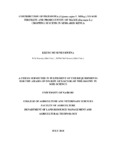| dc.description.abstract | Pigeonpea breeding programs in Kenya have focused mainly on developing high yielding
varieties that are resistant to Fusarium wilt and adaptable to a broad range of ecological
conditions. However, few studies have evaluated these pigeonpea varieties for soil fertility
improvement and contribution to the productivity and sustainability of maize-based cropping
systems under a changing climate. A study comprising field and greenhouse experiments
was conducted between 2009 and 2013 to: (i) quantify the amount of nitrogen fixed by
improved pigeonpea varieties under maize-pigeonpea intercropping systems, (ii) determine
the amount of nitrogen (N), phosphorus (P), potassium (K), magnesium (Mg) and calcium
(Ca) accumulated by the different components of maize-pigeonpea intercropping systems
and its effect on total soil N, available P and exchangeable K, Mg and Ca content, (iii)
determine the effect of pigeonpea and maize residues on soil aggregation and soil water
content, and (iv) predict the impact of climate change on maize and pigeonpea yields.
Field experiments were conducted in Katumani Research Centre using a split-split plot
design with three pigeonpea varieties, two cropping systems and three crop residue
regimes as the main plot, sub-plot, and sub-sub-plot, respectively. Greenhouse
experiments were conducted at Muguga Research Centre where five pigeonpea varieties were
screened for biological nitrogen fixation (BNF) and response to Rhizobia inoculation in
plastic pots filled with 10 kg of soil and replicated four times in a completely randomized
design. Agricultural Production Systems Simulator (APSIM) model version 7.3 was used to
predict the impact of climate change on maize and pigeonpea yields. Data collected on total
soil N and organic carbon (C), available P, exchangeable K, Mg and Ca, N-uptake, BNF, soil
water content, aggregate stability, bulk density and maize and pigeonpea yields were
subjected to analysis of variance using GENSTAT statistical software version 14.2. Results
showed that all the three pigeonpea varieties fixed 60–70 kgN ha-1, meaning they were all
good nitrogen-fixers. However, Mbaazi II fixed significantly (p ≤ 0.05) higher N (70 kg N
ha-1) compared to KAT 60/8 (66 kg N ha-1) and Mbaazi I (62 kg N ha-1) when intercropped
with maize. Pigeonpea had significantly (p ≤ 0.05) higher N uptake compared to maize;
Mbaazi II (84-114 kg N ha-1) absorbed more N followed by Kat 60/8 (29-44 kg N ha-1) and
Mbaazi I (20-37 kg N ha-1). Intercropping maize with pigeonpea reduced (p ≤ 0.05) soil
organic carbon and total soil N from 1.4 and 0.2% in 2009 to less than 1 and 0.1%,
respectively, in 2013. Intercropping maize with long duration pigeonpea (Mbaazi II) and
ploughing back 4 t ha-1 of crop residues had no significant effect on available P. However, it
increased (p ≤ 0.05) available P from 26 ppm at the start of the study to 50 ppm and 47 ppm
in eight seasons under maize-Mbaazi I and maize-Kat 60/8 intercrops, respectively.
Exchangeable K, Mg and Ca also declined significantly (p ≤ 0.05). All the maize-pigeonpea
cropping systems tested in this study did not improve soil physical properties due to very low
soil organic carbon accumulation (< 1%). Instead, they increased soil bulk density beyond the
prescribed range for non-restricted plant growth and reduced soil aggregation thereby
exposing soils to degradation. However, they did not alter texture of the soils at the study site.
Intercropping maize with the three pigeonpea varieties, especially the long duration variety
(Mbaazi II), requires more water compared to maize and pigeonpea sole crops. This can be
addressed by conserving more water in the profile by ploughing back crop residues. Mbaazi
II-maize intercrop offers the best option for farmers in marginal areas like Katumani since it
gave the highest maize (1.9 t ha–1) and pigeonpea (1.4 t ha–1) grain yields and produced
sufficient maize stover (2.1t ha–1) and pigeonpea stalks (2.9 t ha–1) to plough back and feed
the livestock. Simulations showed that maize yields from sole maize crop would increase by
141-150% and 10-23% in 2050 and 2100, respectively. Intercropping maize with pigeonpea
will give mixed results on maize yields. Pigeonpea yields will decline by 10-20 and 4-9% by
2100 under CSIRO and CNRM models, respectively, due to the projected 2°C and 11% increase in temperature and precipitation, respectively. Therefore, efforts should be made to
develop heat and waterlogging-tolerant pigeonpea varieties to help farmers adapt to climate
change and to protect the huge pigeonpea export market currently enjoyed by Kenya. | en_US |

